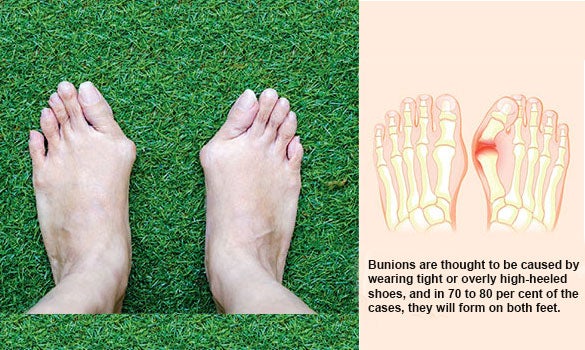
Keyhole surgery with usual benefits now available for less severe bunions.
BUNIONS CAN NOW BE treated easily with surgery, and patients aren’t laid up or have to be on crutches for months during recovery.
Indeed, with new surgical methods, notably keyhole techniques, patients can walk almost immediately after the procedure.
“Many people think there is no cure for bunions, and if there is one, they think they will be on crutches for weeks or months. There are innovations to help them, and if they seek treatment early, these options are quite pain-free,” said Dr Kevin Koo, Consultant, Department of Orthopaedic Surgery, Singapore GeneralHospital (SGH).
A bunion is a crippling bony bump that forms at the base of the big toe as a result of it deviating outwards towards the second toe. Thought to be mainly the result of wearing tight or overly high-heeled shoes, it can cause pain or difficulty in walking. Sufferers can also find it difficult to find shoes that fit.
Bunion plasters, inserts or splints can help ease pressure and relieve pain on the joint, but only surgery can correct the problem. “Once the toe has deviated, it will not straighten again. It may get worse, and can lead to the overlapping of the second and third toes,” said Dr Koo, noting that in the past, patients were oft en told to live with the problem, with surgery the option of last resort.
Now, however, patients are advised to seek treatment early. If the problem is diagnosed at the less severe stage, it can be corrected by keyhole surgery, which involves making five small cuts of just 2mm to 4mm each versus an incision of 5cm to 8cm that is required under conventional open surgery, for doctors to reset the bones and insert screws to keep them in alignment until they bond.
Undergoing either open or keyhole surgery usually involves an overnight stay at the hospital, as general anaesthesia is used. The patient can walk out of the hospital the next day with their bandaged foot protected by a tough sandal – there is no need for crutches. The recovery period is also similar, from two to four weeks.
But keyhole or minimally invasive procedures typically cause less pain and blood loss, and fewer wound complications, and result in quicker recovery.
In a small study by SGH orthopaedic surgeons comparing 29 SGH patients who underwent the latest keyhole surgical method between 2013 and 2014, and 58 open-surgery patients, it was found that the former did as well as the latter group 24 months after surgery. But the keyhole group experienced significantly less pain, a shorter length of operation time, and had less chance of developing wound complications (three who underwent open surgery had wound complications versus none in the other group), according to Dr Koo, the senior author of the study.
Having practised keyhole bunion surgery at SGH since mid-2014, Dr Koo said the method may be a better option for diabetic patients, as they are at a higher risk of getting a post-operative wound infection. Minimally invasive surgery helps decrease this risk.
In 70 to 80 per cent of the cases, bunions will form on both feet. This was what happened to one 36-year-old patient, a corporate trainer who spends most of her working day standing and presenting in front of groups.
Not only did she have bunions on both feet, she also had a bunionette – a small bump on the side of her small toe. As her bunions were considered to be within the parameters of keyhole surgery, the patient was able to choose the less invasive option. She returned to work in less than a month.
While bunions can be dealt with relatively swiftly, they can also return.
“Patients who are more susceptible to seeing bunions return include people with flat feet and those with flexible joints,” said Dr Koo.
One of the worst cases he has dealt with was a 60-year-old Singaporean who wasn’t aware bunions could be treated.
She thought it was just a condition she had to suffer through. She only sought medical help when the condition was so advanced that her toes had all folded under her foot, leaving just the middle toe exposed. The only option available was traditional surgery.
The key message, said Dr Koo, is not to wait. “If you have a visible bump with pain or diff iculty walking, you should see a doctor,” he said.
Bunion basics
Bunions can also form on the little toe, and they are called bunionettes.
The skin takes around two weeks to heal post-surgery; the bones will take up to three months to unite.













 Get it on Google Play
Get it on Google Play